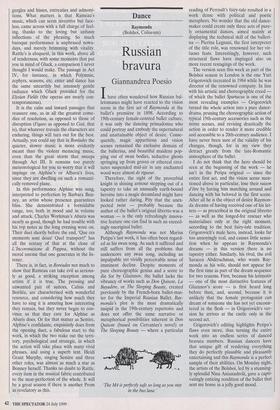Dance
Raymonda (Bolshoi, Coliseum)
Russian bravura
Giannandrea Poesio
Ihave often wondered how Russian bal- letomanes might have reacted to the vision scene in the first act of Raymonda at the ballet's premiere in 1898. According to 19th-century female-centred ballet culture, it was only the dancing primadonna who could portray and embody the supernatural and unattainable object of desire., Conse- quently, magic apparitions and vision scenes remained the exclusive domain of the ballerina, and beautiful maidens pop- ping out of swan bodies, seductive ghosts springing up from graves or ethereal crea- tures suspended mid-air in any enchanted wood were almost de rigueur.
Therefore, the sight of the proverbial knight in shining armour stepping out of a tapestry to take an unusually earth-bound heroine into a magic dreamland might have looked rather daring. Pity that the unex- pected twist — probably because the author of the ballet's original libretto was a woman — is the only refreshingly innova- tive feature one can find in such an exceed- ingly unoriginal ballet.
Although Raymonda was not Marius Petipa's last work, it has often been regard- ed as his swan song. As such it suffered and still suffers from all the problems that underscore any swan song, including an impalpable yet vividly perceivable sense of imminent decline. Despite moments of pure choreographic genius and a score to die for by Glazunov, the ballet lacks the vibrancy of works such as Don Quixote, La Bayadere, or The Sleeping Beauty, created previously by the French-born ballet-mas- ter for the Imperial Russian Ballet. Ray- monda's plot is the most dramatically insipid in the 19th-century repertoire and does not offer the same narrative or metaphorical possibilities inherent in Don Quixote (based on Cervantes's novel) or The Sleeping Beauty — where a particular The M4 is perfectly safe so long as you stay in the bus lane.' reading of Perrault's fairy-tale resulted in a work dense with political and poetic metaphors. No wonder that the old dance- maker could create only three acts of pure- ly ornamental dances, aimed mainly at displaying the technical skill of the balleri- na — Pierina Legnani, the first interpreter of the title role, was renowned for her vir- tuoso feats. Interestingly, however, such structural flaws have impinged also on more recent restagings of the work.
The version seen this week as part of the Bolshoi season in London is the one Yuri Grigorovich recreated in 1984 while he was director of the renowned company. In line with his artistic and choreographic creed of which the ballet Spartacus is one of the most revealing examples — Grigorovich turned the whole action into a pure dance- drama, pruning the choreographic action of typical 19th-century accessories such as the mime scenes, and revising drastically the action in order to render it more credible and accessible to a 20th-century audience. I have never been sure of the validity of his changes, though, for in my view they detract greatly from the late-Romantic atmosphere of the ballet.
I do not think that the hero should be seen at the beginning of the work — he isn't in the Petipa original — since the entire first act, and the vision scene men- tioned above in particular, lose their raison d'être by having him marching around and dancing with his beloved in the first scene. After all he is the object of desire Raymon- da dreams of having received one of his let- ters — as prescribed in the original libretto — as well as the longed-for rescuer who materialises only at the right moment, according to the best fairy-tale tradition. Grigorovich's male hero, instead, looks far too annoyingly real, and causes little sensa- tion when he appears in Raymonda's dreams — in this version there is no tapestry either. Similarly, his rival, the evil Saracen Abderachman, who wants Ray- monda as his wife, should not appear for the first time as part of the dream sequence for two reasons. First, because his leitmotiv — one of the most distinctive features of Glazunov's score — is first heard long before then, and, second, because it is unlikely that the female protagonist can dream of someone she has not yet encoun- tered in the flesh — in Grigorovich's ver- sion he arrives at the castle only in the second act.
Grigorovich's editing highlights Petipa's flaws even more, thus turning the entire work into an endless series of danced bravura numbers. Russian dancers have that unique gift of rendering everything they do perfectly plausible and pleasantly entertaining and this Raymonda is a perfect sample of their abilities. On Monday night, the artists of the Bolshoi, led by a stunning- ly splendid Nina Anianashvili, gave a capti- vatingly enticing rendition of the ballet that sent me home in a jolly good mood.


























































 Previous page
Previous page